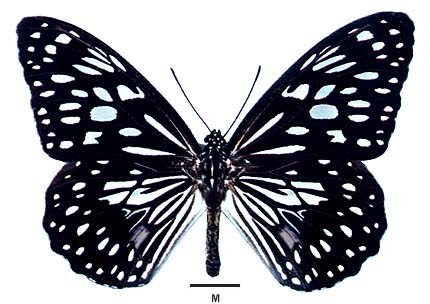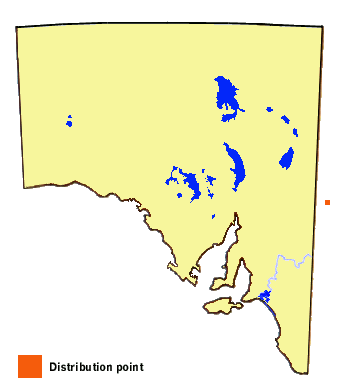Blue Tiger or Blue Wanderer
Tirumala hamata hamata (W.S. Macleay)

Interesting Aspects
A large, distinctive butterfly, similar in size and shape to the related orange Wanderer butterfly. Both sexes are similar, but males can be distinguished by the presence of a large, raised silvery-grey sex pouch in the lower-centre of each hindwing. The males also have a pair of grey "hairpencils" enclosed near the tip of their abdomens, which they can protrude and expand into a feather-like mop and dispense a characteristic scented pheromone that is required for successful courtship.
It is essentially a tropical butterfly with migrant tendencies. During the dry (winter) season when the larva hostplants are in short supply, the butterflies mass together in very large colonies in cool, shady areas, usually along moist creek lines. These groups can contain thousands of butterflies in which the females are reproductively dormant. Individual butterflies have been reported to survive for 5 months or more during this period. When the wet (summer) season breaks and the hostplants begin to flourish, the females become reproductive and disperse to the breeding grounds in the coastal vine thickets. As numbers again buildup, full of fat reserves, many fly southwards as migrants. Along the eastern seaboard of Australia they can reach as far south as eastern Victoria. They can form local semi-resident breeding colonies as far south as northern NSW, but further south they are biologically unsuited to the cooler conditions. During favourable, moist summers, some of these migrations occur further inland, and have been recorded at Mt Isa and Broken Hill.
The entire life history of the butterfly is poisonous, in varying degrees. Its milkweed hostplants contain poisons, which the larva is able to isolate and retain in its body as a protection against vertebrate predation. These poisons can be passed on to the pupa and the adult butterfly. The latter can further top up its poisons by imbibing (sucking and assimilating) the sap and surface exudates from the hostplant again, or from other poisonous plants. From the latter the male butterfly obtains further poisons (pyrrolizidine alkaloids), which are necessary for the production of the hair-pencil pheromones. The pyrrolizidine poisons are also emitted as a defence mechanism through the hair-pencils when the male butterfly is attacked, or even when it is roughly man handled. The cardiac glycoside poisons are passed onto the eggs by the female to complete the cycle. These poisons are usually in sufficient concentrations to only sicken the vertebrate predators or at least taste unpalatable, so that the predators can learn from the experience and pass on the mistake. They are not meant to cause death as this would likely result in larger numbers of the insect being killed.
In northern Australia the flight is normally slow and graceful, but if disturbed the butterfly can make off with great speed. The slow flight is typical for poisonous species of butterflies, which gives predatory birds sufficient time for recognition. Both sexes are easily approached during normal flight.
